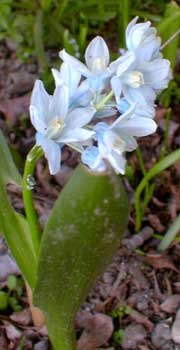
Striped Squill; or,
Lebanese Squill
"Angels in the early morning
May be seen the dews among.
Stooping, plucking, smiling, flying.
Do the buds to them belong?"
-Emily Dickinson
(1830-1886)
(1830-1886)
Puschkinia scilloides var libanotica has been gardened since 1808. It is an extremely hardy flower growing to only six or eight inches tall, with sprays of palest pale blue six-petalled flowers that come close to an iceberg white, with a thin deep blue stripe down the center of each petal. There is also a genuinely white form called "Alba."
Native from Turkey & the Caucasus & to Iran, Iraq & Lebanon, this last location gave it the taxonomic name libanotica for the specific variant. The species name scilloides means "resembles scilla," though it more resembles its close cousin Chionodoxa.
Like chionodoxa & crocuses, the bulbs can be put out in autumn amidst short grass to naturalize in corners of the lawn that won't be traipsed on. It can be quite pleasing to plant them just outside the garden proper in an abutted lawn, so that the garden & lawn have a transition zone with crocuses, chiondoxas, & puschkineas.
The genus is named for Count Apollo Apollosovich Mussin-Puschkin (d. 1815), an 18th Century Russian chemist & plant collector. He launched a famous plant expedition to the Caucasus in 1802. Several of the expedition's plant discoveries have remained garden standards since.
Rather like muscaris & scillas, the bulb placement is not critical, except to bare in mind how small they are. They can be planted from one to five inches deep; spaced from one to three inches apart.
Striped Scilla is very adaptable & will grow in almost any situation in the garden. It likes sun either morning or afternoon, but gets by in considerably more shade. They especially like it under deciduous shrubs or trees, & are blooming early enough in late winter or early spring to get a bit of extra sun before the trees regain their leaves.
We planted twenty-five bulbs in Autumn 2003. We got them out a bit late in the season, when bulbs go on close-out sales. Testing their fame for hardship, they went into dryish deep shade against the house, between a Red Barberry & a Golden Barberry.
This spot formerly belonged to several kinds of narcissus but as surrounding shrubbery made it too shady for them, those bulbs were lifted & moved to a sunny spot. Because the Striped Squill is described as forgiving of poorer locations, & the bulbs were damned cheap, it seemed worth the risk to see if we could get them to naturalize in less than optimal locations, where in fact something like White English Squills would feel very much at ease, but we already had White English Squills in too many places so wanted to try the Puschkinea instead.
The first fat leaves were appearing along with flower buds before the end of March, & they were in flower for April. Snails alas found the young leaves tasty. Being close to the trunk of a tree keeps the bulbs dry in winter when they are somewhat at risk of rotting if over moist. It otherwise likes moderate amounts of moisture during its growth period, & droughty conditions during the bulbs' summer dormancy.
They did not do all that well in the harsh area we tried for them, & mainly they were too small to be noticeable, so it turned out to be a poor location for them. I didn't lift them to move elsewhere because I felt they might yet naturalize & do better in coming years, & if they reproduced over time, they might actually become noticeable even back there in the dry shade.
But in case that spot really is just too dismal for them to do anything but dwindle each year, in 2004 I planted another twenty-five bulbs, amidst bright blue equally miniature Siberian squill, in the crack between flagstones & a stone wall. In this spot they get a bit of watering in bright shade or dappled sunlight & need never be so extremely tested for their hardy forgivenesses.
It naturalizes quickly in an undisturbed area, both from bulb offsets & self-seeding. In the wild it grows at considerable elevations, so is not fussy about temperature conditions, & is good for zones five through nine, & possibly down to zone three with heavy mulching for winter. At the colder range, it will bloom later in spring. Once established, it will become impervious to injury & remain in the garden forever.